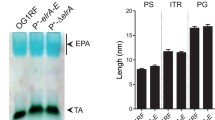Abstract
TwelveEdwardsiella tarda strains investigated proved to be strongly invasive for HeLa cells. All strains were negative in the Serény test and did not produce either enterotoxins LT and ST or cytotoxin detectable by the Y1, the infant mouse, and the Vero tests respectively. All strains were hemolytic on blood agar plates.
Similar content being viewed by others
Literature Cited
Bhat, P., Myers, R. M., Carpenter, K. P. 1967.Edwardsiella tarda in a study of juvenile diarrhea. Journal of Hygiene65: 293–298.
Birnboim, H. C., Doly J. 1979. A rapid alkaline extraction procedure for screening recombinant plasmid DNA. Nucleic Acids Research7: 1513–1523.
Chatty, H. B., Gavan, T. L. 1968.Edwardsiella tarda—identification and clinical significance: report of two cases. Cleveland Clinic Quarterly35: 223–228.
Clarridge, J. E., Musher, D. M., Fainstein, V., Wallace, Jr., R. J. 1980. Extraintestinal human infection caused byEdwardsiella tarda. Journal of Clinical Microbiology11: 511–514.
Dean, A. G., Ching, Y. C., Williams, R. G., Harden, L. B. 1972. Test forEscherichia coli enterotoxin using infant mice: application in a study of diarrhea in children in Honolulu. Journal of Infectious Diseases125: 407–411.
Donta, S. T., Moon, H. W., Whipp, S. C. 1974. Detection of heat-labileEscherichia coli enterotoxin with the use of adrenal cells in tissue culture. Science183: 334–336.
Farmer III, J. J. 1981. The genusEdwardsiella. In: The prokaryotes, a handbook on habitats, isolation, and identification of bacteria, pp. 1135–1139. Berlin: Springer-Verlag.
Feeley, J. C., Wells, J. C., Tsai, T. F., Puhr, N. D. 1979. Detection of enterotoxigenic and invasive strains ofYersinia enterocolitica. Contributions to Microbiology and Immunology5: 329–334.
Giannella, R. A., Washington, O., Gemski, P., Formal, S. B. 1973. Invasion of HeLa cells bySalmonella typhimurium: a model for study of invasiveness ofSalmonella. Journal of Infectious Diseases128: 69–75.
Gilman, R. H., Madasamy, M., Gan, E., Mariappan, M., Davis, C. E., Kyser, K. A. 1971.Edwardsiella tarda in jungle diarrhoea and a possible association withEntamoeba histolytica. Southeast Asian Journal of Tropical Medicine and Public Health2: 186–189.
Harris, J. R., Wachsmuth, I. K., Davis, B. R., Cohen, M. L. 1982. High-molecular-weight plasmid correlates withEscherichia coli enteroinvasiveness. Infection and Immunity37: 1295–1298.
Jones, G. W., Rabert, D. K., Svinarich, D. M., Whitfield, H. J. 1982. Association of adhesive, invasive, and virulent phenotypes ofSalmonella typhimurium with autonomous 60-megadalton plasmids. Infection and Immunity38: 476–486.
Konowalchuk, J., Speirs, J. I., Stavric, S. 1977. Vero response to a cytotoxin ofEscherichia coli. Infection and Immunity18: 775–779.
Lee, W. H., McGrath, P. P., Carter, P. H., Edide, E. L. 1977. The ability of someYersinia enterocolitica strains to invade HeLa cells. Canadian Journal of Microbiology23: 1714–1722.
Makulu, A., Gatti, F., Vandepitte, J. 1973.Edwardsiella tarda infections in Zaire. Annales de la Société Belge de Médecine Tropicale (Bruxelles)53: 165–172.
Marsh, P. K., Gorbach, S. L. 1982. Invasive enterocolitis caused byEdwardsiella tarda. Gastroenterology82: 336–338.
Ogawa, H., Nakamura, A., Sakazaki, R. 1968. Pathogenic properties of “enteropathogenic”Escherichia coli from diarrheal children and adults. Japanese Journal of Medical Science and Biology21: 333–349.
Rao, K. R. P., Shah, J., Rajashekaraiah, K. R., Patel, A. R., Miskew, D. B., Fennewald, P. S. 1981.Edwardsiella tarda osteomyelitis in a patient with SC hemoglobinopathy. Southern Medical Journal74: 288–292.
Sansonetti, P. J., Kopecko, D. J., Formal, S. B. 1982. Involvement of a plasmid in the invasive ability ofShigella flexneri. Infection and Immunity35: 852–860.
Serény, B. 1957. Experimental keratoconjunctivitis shigellosa. Acta Microbiologica Academiae Scientiarum Hungaricae4: 367–376.
Silva, R. M., Toledo, M. R. F., Trabulsi, L. R. 1982. Plasmidmediated virulence inShigella species. Journal of Infectious Diseases146: 99.
Silva, R. M., Toledo, M. R. F., Trabulsi, L. R. 1982. Correlation of invasiveness with plasmid in enteroinvasive strains ofEscherichia coli. Journal of Infectious Diseases146: 706.
Tenner, C., Rácz, P., Rédey, B. 1971. Significance of the “epithelial phase” in experimentalSalmonella conjunctivitis. Acta Microbiologica Academiae Scientiarum Hungaricae18: 167–177.
Toledo, M. R. F., Serafim, M. B., Horton, D. S. P. Q., Falcão, D. P. 1982. Pesquisa de fatores de virulência emYersinia enterocolitica. Revista de Microbiologia, São Paulo13: 143–150.
Trabulsi, L. R., Fernandes, M. R. F., Zuliani, M. E. 1967. Novas bactérias patogênicas para o intestino do homen. Revista do Instituto de Medicina Tropical de São Paulo9: 31–39.
Zink, D. L., Feeley, J. C., Wells, J. G., Vanderzant, C., Vickery, J. C., Roof, W. D., O'Donovan, G. A. 1980. Plasmid-mediated tissue invasiveness inYersinia enterocolitica. Nature (London)283: 224–226.
Author information
Authors and Affiliations
Rights and permissions
About this article
Cite this article
Marques, L.R.M., Toledo, M.R.F., Neusa, P.S. et al. Invasion of HeLa cells byEdwardsiella tarda . Current Microbiology 10, 129–132 (1984). https://doi.org/10.1007/BF01576772
Issue Date:
DOI: https://doi.org/10.1007/BF01576772




